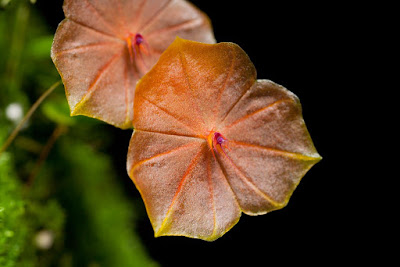Lepanthes telipogoniflora is endemic to Colombia, and is one of the most heat resistant in the Lepanthes genus. It grows in the woods on the Western Cordillera at an altitude of about 500 meters...
Lepanthes telipogoniflora also called as The Telipogon-Like Lepanthes, is a species of the genus Lepanthes. This species was described by André Schuiteman & A.de Wilde in 1996.
IDENTIFY LEPANTHES TELIPOGONIFLORA
Lepanthes telipogoniflora is endemic to Colombia, and is one of the most heat resistant in the Lepanthes genus. It grows in the woods on the Western Cordillera at an altitude of about 500 meters.
It is a mini-miniature sized, hot to warm growing epiphyte with slender, erect ramicauls enveloped by 4 to 5 microscopically ciliate lepanthi-form sheaths and carrying a single, apical, erect, coriaceous, elliptical, obtuse, broadly cuneate below into the petiolate base, 1 - 1.4 cm long leaf.
The Telipogon-Like Lepanthes blooms in the spring on a slender, lax, .1 to 1.5 cm long, successively single, few flowered inflorescence. The small (up to 1.5 - 2 cm in diameter) flowers are however very large compared to other Lepanthes.
LEPANTHES TELIPOGONIFLORA CARE AND CULTURE
Cultural information should only be used as a guide, and should be to be adapted to suit you. Your physical location; where you grow your plants, how much time you have to devote to their care, and many other factors, will need to be taken into account. Only then can you decide on the cultural methods that best suit you and your plants.
Light:
Lepanthes telipogoniflora needs a light level of 16000-22000 lux. It must be protected from direct sunlight. The recommended photoperiod is 12 hours.
Temperature:
It is an intermediate-hot thermal requirements species. The ideal temperatures are 24-26 ° C during the day and 19-20 ° C at night.
Humidity:
The air humidity must be high enough, around 80%, but only if The Telipogon-Like Lepanthes is grown on a raft. If it is in a pot, humidity can drop to 65-70%.
Substrate, growing media and repotting:
Lepanthes telipogoniflora can be grown in pots or on a raft. In the last case it is very important to put the sphagnum or other moss under the roots and keep the humidity of air very high, 80-85%, otherwise the plant will not be able to develop. If it comes to growing in pots, I recommend a mixture of sphagnum and perlite (1: 1) as a substrate. In spite of the fact that this orchid loves the damp much, the stagnation of water inside the vase should not occur, since they easily provoke the root rottenness.
Watering:
Throughout the year this species gets water abundantly and frequently as soon as the substratum has dried up enough. It must never become completely dry, because this will lead to the decay of the plant.
Fertilizer:
This orchid is fertilized every 3 watering (but no more often than once a week), using 1/4 of the dose indicated on the bottle of a special liquid fertilizer for orchids. Before fertilizing the plant it is necessary to water it: this avoids the harmful contact of the fertilizer with the dry roots.
Rest period:
Lepanthes telipogoniflora can bloom in any season and does not need any period of rest. In winter, the amount of water can somewhat reduced but the plant can not stay dry for long period. Fertilization should abandoned until strong watering resumes.















COMMENTS